spare wheel TOYOTA AURIS 2013 Owners Manual (in English)
[x] Cancel search | Manufacturer: TOYOTA, Model Year: 2013, Model line: AURIS, Model: TOYOTA AURIS 2013Pages: 768, PDF Size: 21.22 MB
Page 5 of 768
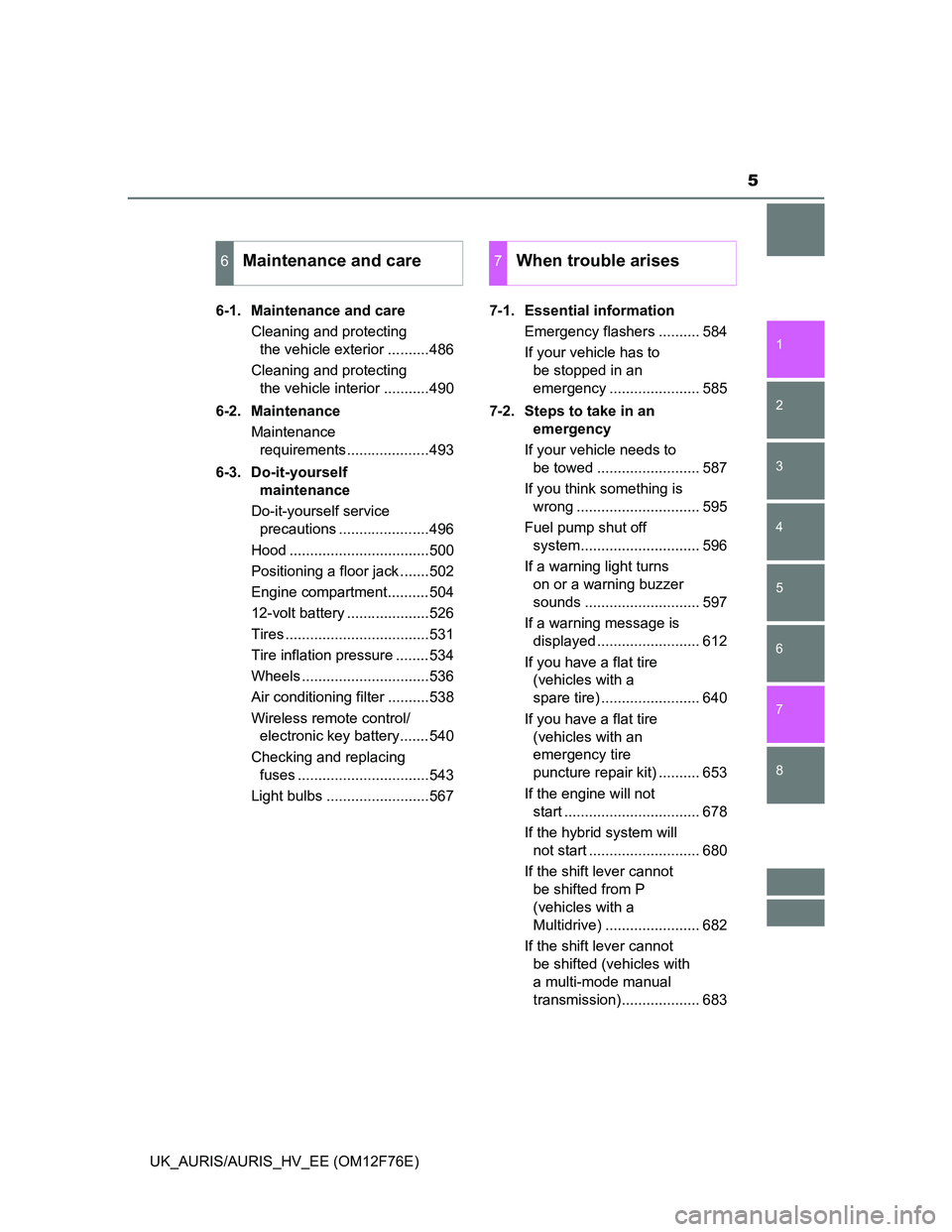
5
1
8 7
6
5
4
3
2
UK_AURIS/AURIS_HV_EE (OM12F76E)6-1. Maintenance and care
Cleaning and protecting
the vehicle exterior ..........486
Cleaning and protecting
the vehicle interior ...........490
6-2. Maintenance
Maintenance
requirements....................493
6-3. Do-it-yourself
maintenance
Do-it-yourself service
precautions ......................496
Hood ..................................500
Positioning a floor jack .......502
Engine compartment..........504
12-volt battery ....................526
Tires ...................................531
Tire inflation pressure ........534
Wheels ...............................536
Air conditioning filter ..........538
Wireless remote control/
electronic key battery.......540
Checking and replacing
fuses ................................543
Light bulbs .........................5677-1. Essential information
Emergency flashers .......... 584
If your vehicle has to
be stopped in an
emergency ...................... 585
7-2. Steps to take in an
emergency
If your vehicle needs to
be towed ......................... 587
If you think something is
wrong .............................. 595
Fuel pump shut off
system............................. 596
If a warning light turns
on or a warning buzzer
sounds ............................ 597
If a warning message is
displayed ......................... 612
If you have a flat tire
(vehicles with a
spare tire) ........................ 640
If you have a flat tire
(vehicles with an
emergency tire
puncture repair kit) .......... 653
If the engine will not
start ................................. 678
If the hybrid system will
not start ........................... 680
If the shift lever cannot
be shifted from P
(vehicles with a
Multidrive) ....................... 682
If the shift lever cannot
be shifted (vehicles with
a multi-mode manual
transmission)................... 683
6Maintenance and care7When trouble arises
Page 251 of 768
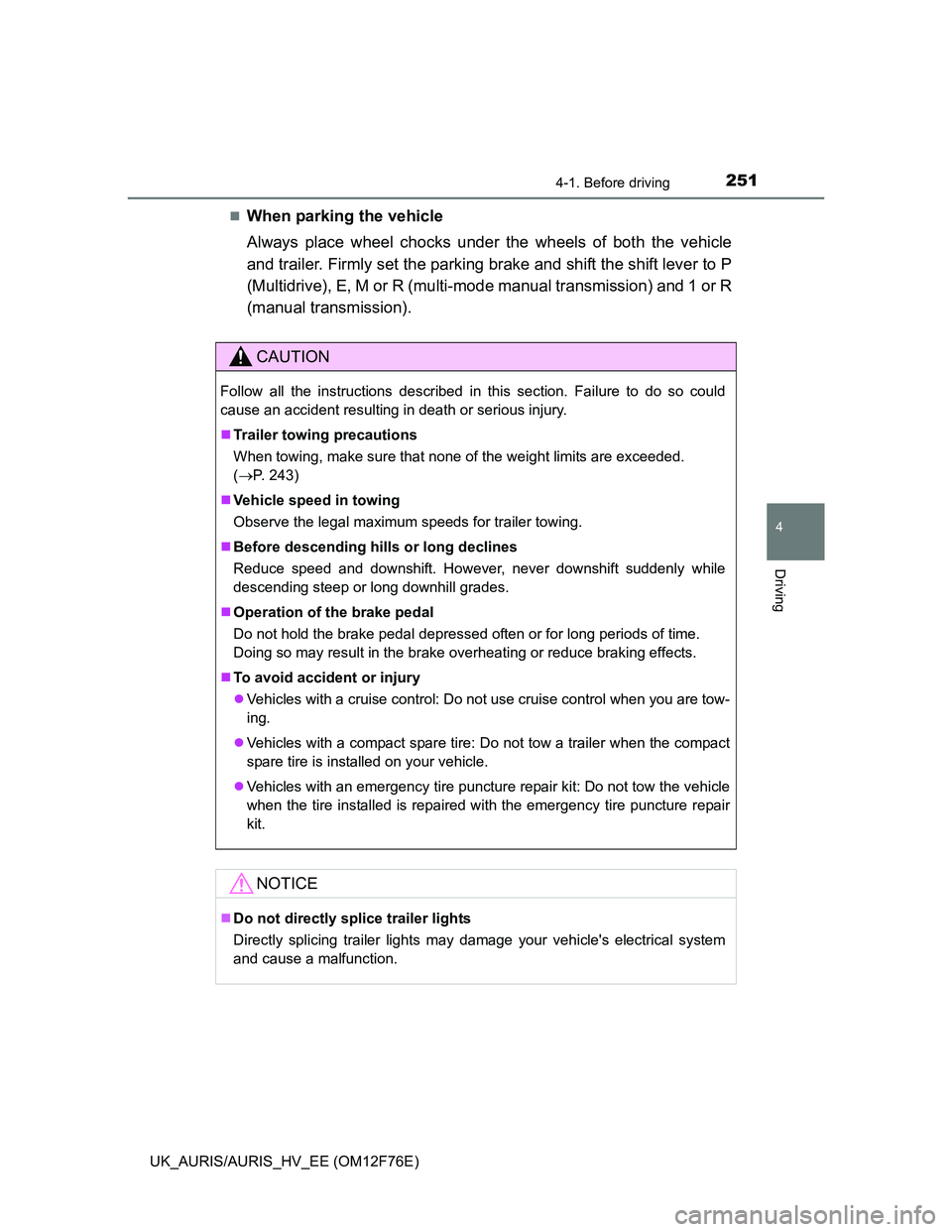
2514-1. Before driving
UK_AURIS/AURIS_HV_EE (OM12F76E)
4
Driving
When parking the vehicle
Always place wheel chocks under the wheels of both the vehicle
and trailer. Firmly set the parking brake and shift the shift lever to P
(Multidrive), E, M or R (multi-mode manual transmission) and 1 or R
(manual transmission).
CAUTION
Follow all the instructions described in this section. Failure to do so could
cause an accident resulting in death or serious injury.
Trailer towing precautions
When towing, make sure that none of the weight limits are exceeded.
(P. 243)
Vehicle speed in towing
Observe the legal maximum speeds for trailer towing.
Before descending hills or long declines
Reduce speed and downshift. However, never downshift suddenly while
descending steep or long downhill grades.
Operation of the brake pedal
Do not hold the brake pedal depressed often or for long periods of time.
Doing so may result in the brake overheating or reduce braking effects.
To avoid accident or injury
Vehicles with a cruise control: Do not use cruise control when you are tow-
ing.
Vehicles with a compact spare tire: Do not tow a trailer when the compact
spare tire is installed on your vehicle.
Vehicles with an emergency tire puncture repair kit: Do not tow the vehicle
when the tire installed is repaired with the emergency tire puncture repair
kit.
NOTICE
Do not directly splice trailer lights
Directly splicing trailer lights may damage your vehicle's electrical system
and cause a malfunction.
Page 359 of 768
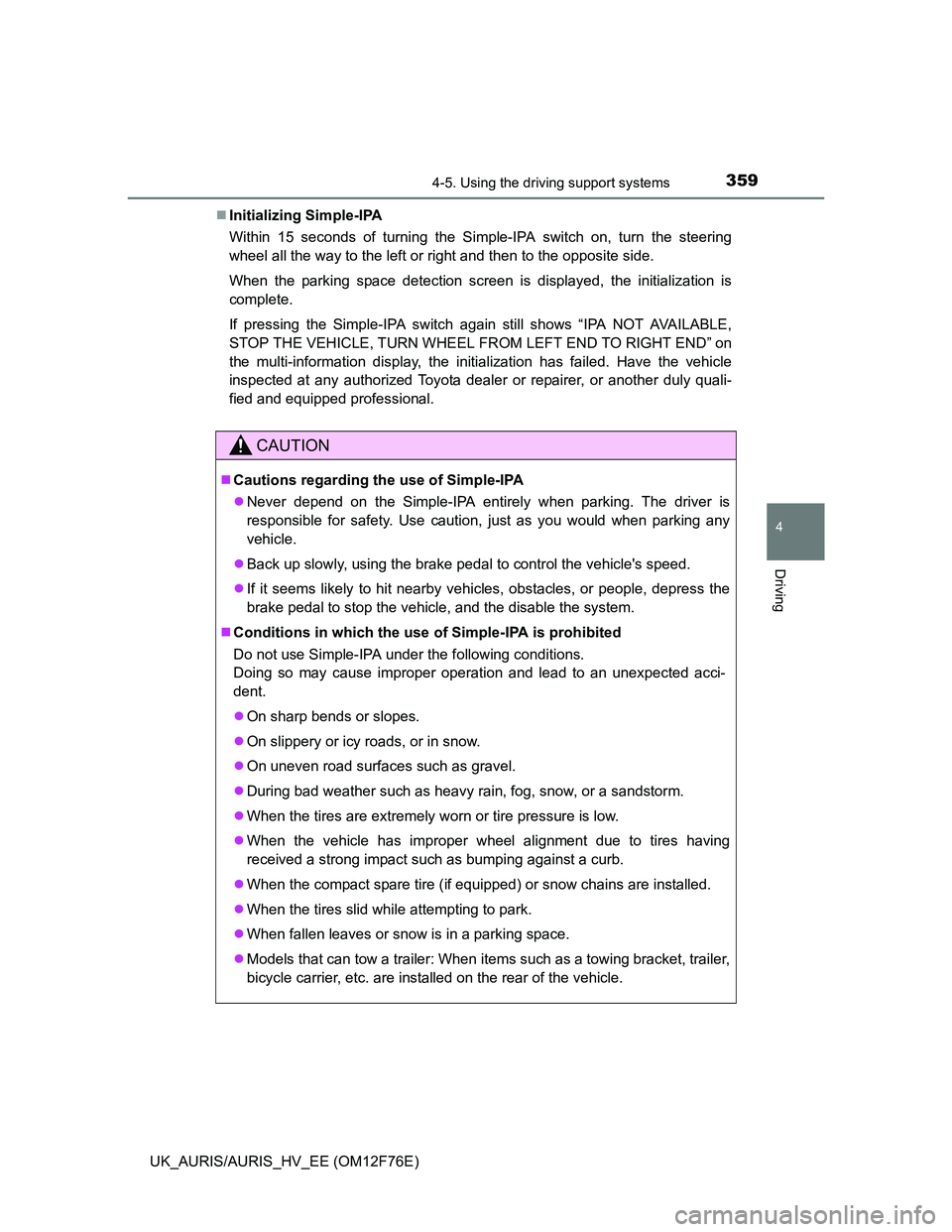
3594-5. Using the driving support systems
UK_AURIS/AURIS_HV_EE (OM12F76E)
4
Driving
Initializing Simple-IPA
Within 15 seconds of turning the Simple-IPA switch on, turn the steering
wheel all the way to the left or right and then to the opposite side.
When the parking space detection screen is displayed, the initialization is
complete.
If pressing the Simple-IPA switch again still shows “IPA NOT AVAILABLE,
STOP THE VEHICLE, TURN WHEEL FROM LEFT END TO RIGHT END” on
the multi-information display, the initialization has failed. Have the vehicle
inspected at any authorized Toyota dealer or repairer, or another duly quali-
fied and equipped professional.
CAUTION
Cautions regarding the use of Simple-IPA
Never depend on the Simple-IPA entirely when parking. The driver is
responsible for safety. Use caution, just as you would when parking any
vehicle.
Back up slowly, using the brake pedal to control the vehicle's speed.
If it seems likely to hit nearby vehicles, obstacles, or people, depress the
brake pedal to stop the vehicle, and the disable the system.
Conditions in which the use of Simple-IPA is prohibited
Do not use Simple-IPA under the following conditions.
Doing so may cause improper operation and lead to an unexpected acci-
dent.
On sharp bends or slopes.
On slippery or icy roads, or in snow.
On uneven road surfaces such as gravel.
During bad weather such as heavy rain, fog, snow, or a sandstorm.
When the tires are extremely worn or tire pressure is low.
When the vehicle has improper wheel alignment due to tires having
received a strong impact such as bumping against a curb.
When the compact spare tire (if equipped) or snow chains are installed.
When the tires slid while attempting to park.
When fallen leaves or snow is in a parking space.
Models that can tow a trailer: When items such as a towing bracket, trailer,
bicycle carrier, etc. are installed on the rear of the vehicle.
Page 532 of 768

5326-3. Do-it-yourself maintenance
UK_AURIS/AURIS_HV_EE (OM12F76E)
Rotate the tires in the order shown.
To equalize tire wear and help extend tire life, Toyota recommends
that tire rotation is carried out approximately every 10000 km (6000
miles).
Low profile tires (17-inch tires)
Generally, low profile tires will wear more rapidly and tire grip performance
will be reduced on snowy and/or icy roads when compared to standard tires.
Be sure to use snow tires or tire chains on snowy and/or icy roads and drive
carefully at a speed appropriate for road and weather conditions.
If the tread on snow tires wears down below 4 mm (0.16 in.)
The effectiveness of the tires as snow tires is lost.
Tire rotation
Vehicles with a spare tire of a
different wheel type from the
installed tiresVehicles with a spare tire of
the same wheel type as the
installed tires
FrontFront
Page 533 of 768
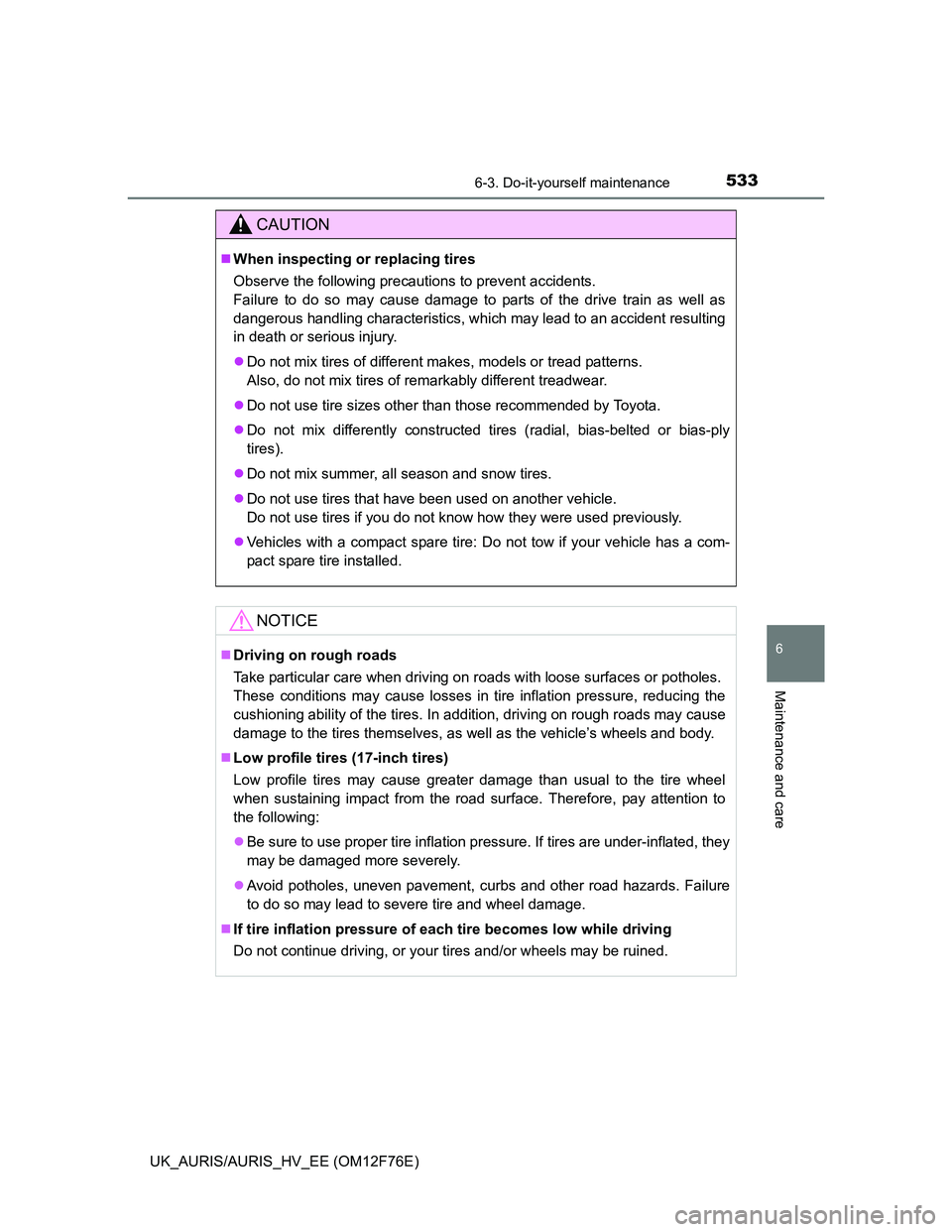
5336-3. Do-it-yourself maintenance
UK_AURIS/AURIS_HV_EE (OM12F76E)
6
Maintenance and care
CAUTION
When inspecting or replacing tires
Observe the following precautions to prevent accidents.
Failure to do so may cause damage to parts of the drive train as well as
dangerous handling characteristics, which may lead to an accident resulting
in death or serious injury.
Do not mix tires of different makes, models or tread patterns.
Also, do not mix tires of remarkably different treadwear.
Do not use tire sizes other than those recommended by Toyota.
Do not mix differently constructed tires (radial, bias-belted or bias-ply
tires).
Do not mix summer, all season and snow tires.
Do not use tires that have been used on another vehicle.
Do not use tires if you do not know how they were used previously.
Vehicles with a compact spare tire: Do not tow if your vehicle has a com-
pact spare tire installed.
NOTICE
Driving on rough roads
Take particular care when driving on roads with loose surfaces or potholes.
These conditions may cause losses in tire inflation pressure, reducing the
cushioning ability of the tires. In addition, driving on rough roads may cause
damage to the tires themselves, as well as the vehicle’s wheels and body.
Low profile tires (17-inch tires)
Low profile tires may cause greater damage than usual to the tire wheel
when sustaining impact from the road surface. Therefore, pay attention to
the following:
Be sure to use proper tire inflation pressure. If tires are under-inflated, they
may be damaged more severely.
Avoid potholes, uneven pavement, curbs and other road hazards. Failure
to do so may lead to severe tire and wheel damage.
If tire inflation pressure of each tire becomes low while driving
Do not continue driving, or your tires and/or wheels may be ruined.
Page 640 of 768
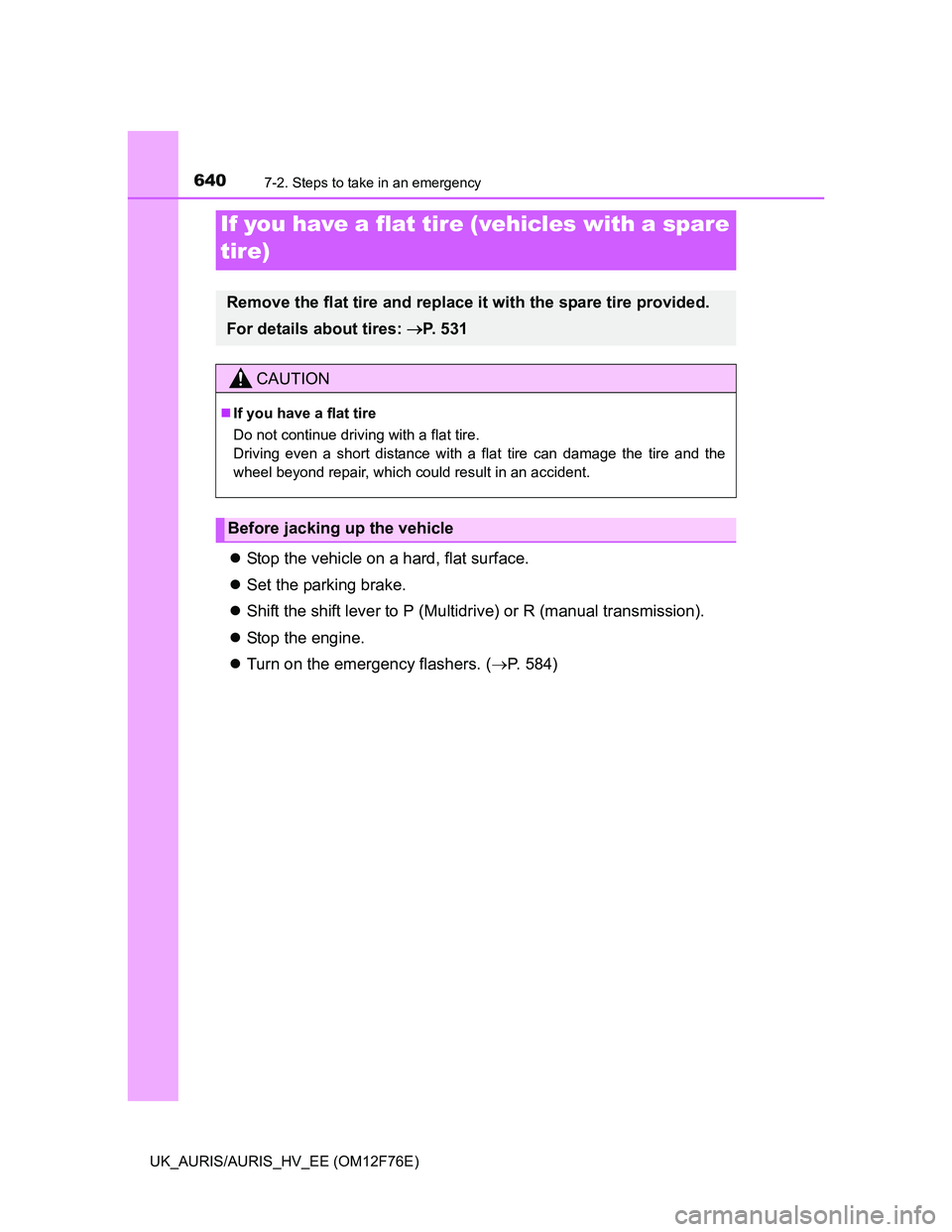
6407-2. Steps to take in an emergency
UK_AURIS/AURIS_HV_EE (OM12F76E)
Stop the vehicle on a hard, flat surface.
Set the parking brake.
Shift the shift lever to P (Multidrive) or R (manual transmission).
Stop the engine.
Turn on the emergency flashers. (P. 584)
If you have a flat tire (vehicles with a spare
tire)
Remove the flat tire and replace it with the spare tire provided.
For details about tires: P. 531
CAUTION
If you have a flat tire
Do not continue driving with a flat tire.
Driving even a short distance with a flat tire can damage the tire and the
wheel beyond repair, which could result in an accident.
Before jacking up the vehicle
Page 641 of 768
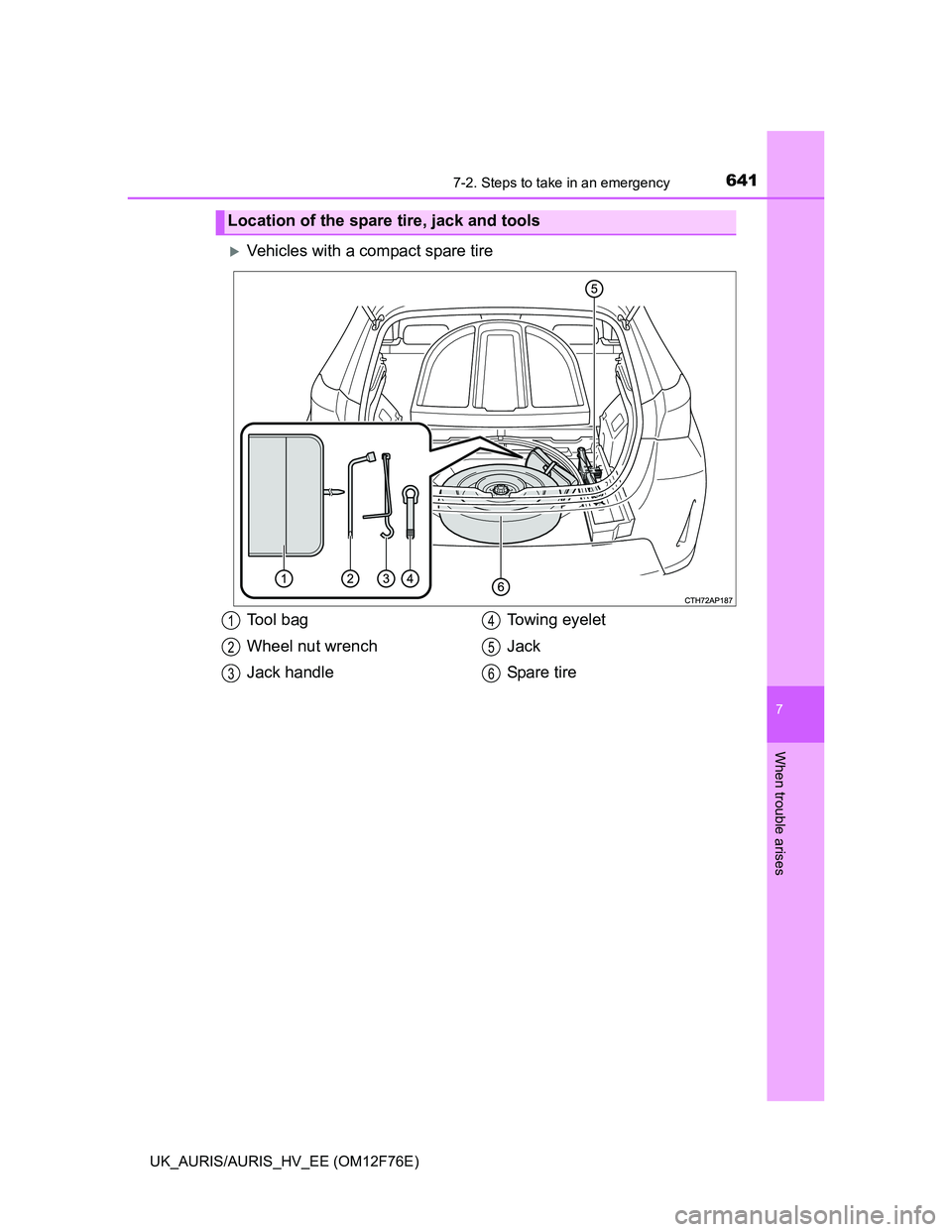
6417-2. Steps to take in an emergency
UK_AURIS/AURIS_HV_EE (OM12F76E)
7
When trouble arises
Vehicles with a compact spare tire
Location of the spare tire, jack and tools
Tool bag
Wheel nut wrench
Jack handleTowing eyelet
Jack
Spare t i re1
2
3
4
5
6
Page 642 of 768
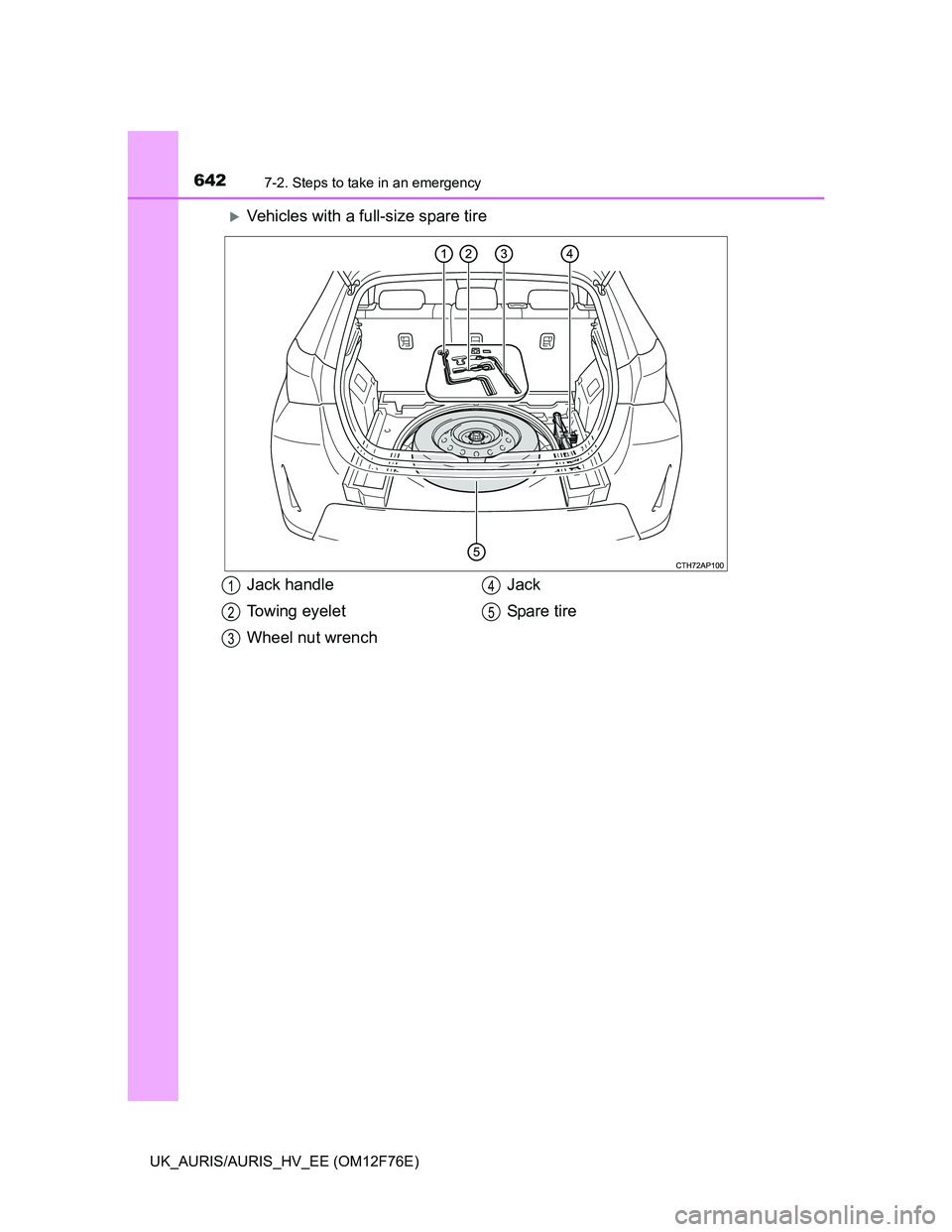
6427-2. Steps to take in an emergency
UK_AURIS/AURIS_HV_EE (OM12F76E)
Vehicles with a full-size spare tire
Jack handle
Towing eyelet
Wheel nut wrenchJack
Spare t i re1
2
3
4
5
Page 646 of 768

6467-2. Steps to take in an emergency
UK_AURIS/AURIS_HV_EE (OM12F76E)
Turn the tire jack portion “A” by
hand until the notch of the jack
is in contact with the jack point.
The jack point guides are located
under the rocker panel. They indi-
cate the jack point positions.
Raise the vehicle until the tire is slightly raised off the ground.
Remove all the wheel nuts and
the tire.
When resting the tire on the
ground, place the tire so that the
wheel design faces up to avoid
scratching the wheel surface.
4
5
Vehicles with a compact spare
tireVehicles with a full-size spare
tire
6
Page 647 of 768
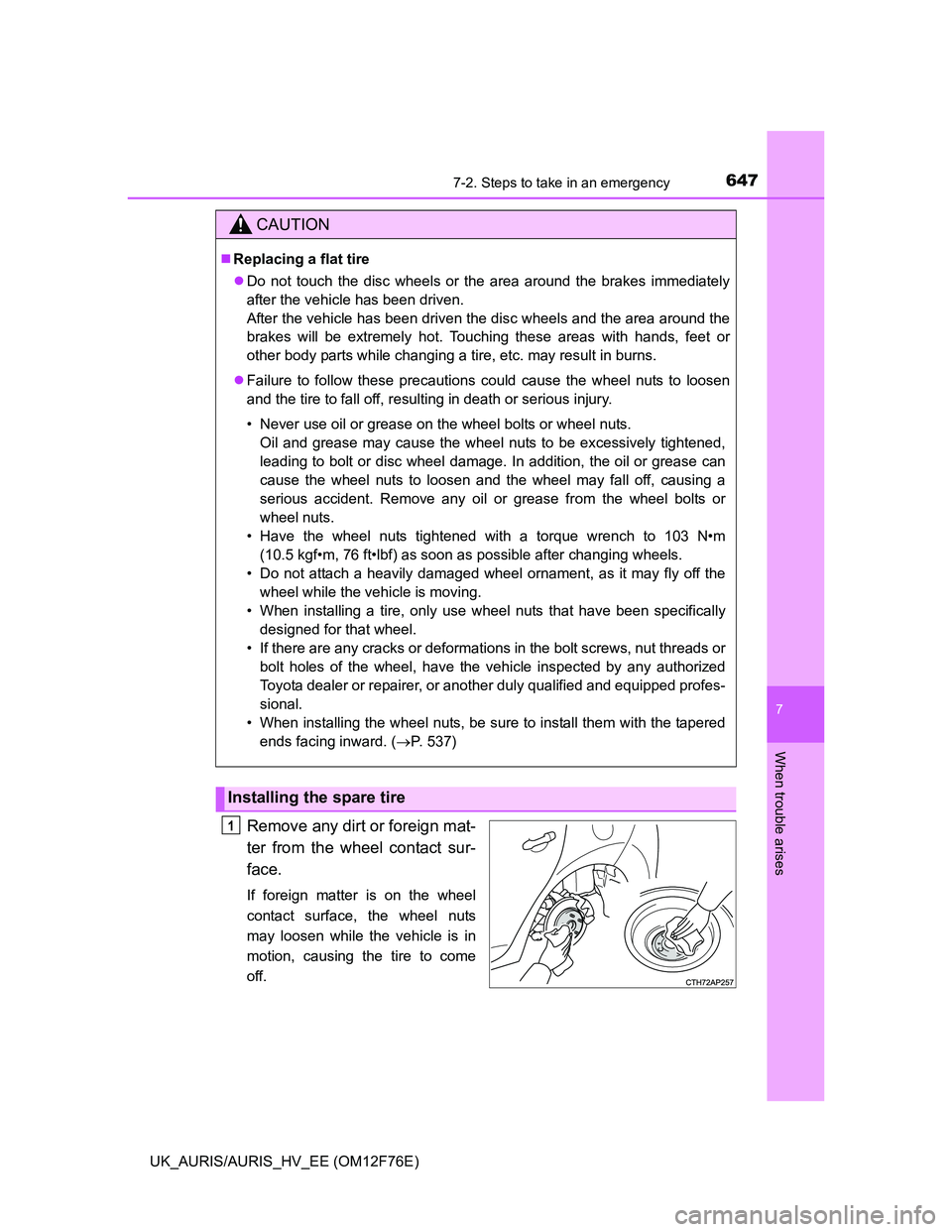
6477-2. Steps to take in an emergency
UK_AURIS/AURIS_HV_EE (OM12F76E)
7
When trouble arises
Remove any dirt or foreign mat-
ter from the wheel contact sur-
face.
If foreign matter is on the wheel
contact surface, the wheel nuts
may loosen while the vehicle is in
motion, causing the tire to come
off.
CAUTION
Replacing a flat tire
Do not touch the disc wheels or the area around the brakes immediately
after the vehicle has been driven.
After the vehicle has been driven the disc wheels and the area around the
brakes will be extremely hot. Touching these areas with hands, feet or
other body parts while changing a tire, etc. may result in burns.
Failure to follow these precautions could cause the wheel nuts to loosen
and the tire to fall off, resulting in death or serious injury.
• Never use oil or grease on the wheel bolts or wheel nuts.
Oil and grease may cause the wheel nuts to be excessively tightened,
leading to bolt or disc wheel damage. In addition, the oil or grease can
cause the wheel nuts to loosen and the wheel may fall off, causing a
serious accident. Remove any oil or grease from the wheel bolts or
wheel nuts.
• Have the wheel nuts tightened with a torque wrench to 103 N•m
(10.5 kgf•m, 76 ft•lbf) as soon as possible after changing wheels.
• Do not attach a heavily damaged wheel ornament, as it may fly off the
wheel while the vehicle is moving.
• When installing a tire, only use wheel nuts that have been specifically
designed for that wheel.
• If there are any cracks or deformations in the bolt screws, nut threads or
bolt holes of the wheel, have the vehicle inspected by any authorized
Toyota dealer or repairer, or another duly qualified and equipped profes-
sional.
• When installing the wheel nuts, be sure to install them with the tapered
ends facing inward. (P. 537)
Installing the spare tire
1